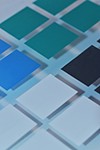 Whether on baby bottles, beer mugs or perfume bottles, imprints on glass consist mainly of lead oxide. Fraunhofer researchers have developed printing inks for glass that do not contain any toxic elements. At the glasstec tradefair from October 21st to 24th in Düsseldorf, they are going to present the new imprints (Hall 15, Booth A33).
Whether on baby bottles, beer mugs or perfume bottles, imprints on glass consist mainly of lead oxide. Fraunhofer researchers have developed printing inks for glass that do not contain any toxic elements. At the glasstec tradefair from October 21st to 24th in Düsseldorf, they are going to present the new imprints (Hall 15, Booth A33).
The perfume bottles seem almost like little works of art: made of stained glass, elegantly formed and decorated with imprints. But the decorative graphics and fonts that are emblazoned on them really make an impression: They are made of special glasses containing up to 50 percent by weight of lead oxide, which can be dangerous to one's health. To decorate the bottles, manufacturers grind these special glasses together with inorganic pigments, print them as pastes on the base glass and melt them on. As a result, the colors are just as durable as the glass itself. Beer mugs, baby bottles and pharmaceutical glass products, such as vials, are decorated and labeled in about like the perfume bottles are.
In the future, a new EU Directive will banish the potentially unhealthy lead oxide from the logos. But this is far from simple: in order for the printing inks to hold permanently, they have to be made of chemically resistant glass. However, they usually contain a lot of silicon dioxide, and therefore have to be melted above 1600 degrees Celsius – a temperature that the base glass would not withstand without becoming deformed. The added lead oxide lowers the melting temperature to below 600 degrees Celsius, thereby creating viable processing conditions. As a last resort, manufacturers are replacing the lead oxide with bismuth oxide. However, that, too, is problematic: Bismuth is dangerous to one's health as well as to the environment. It also multiplies the price of the imprints.
Colorful decor without pollutants
A new development by researchers at the Fraunhofer Institute for Silicate Research ISC in Würzburg and the Forschungsgemeinschaft Technik und Glas e.V. FTG can change
that. "We have developed lead oxide free decorative paints, which do perfectly well without toxic substances," says Anika Deinhardt, researcher at the ISC. "They are easy to process, have high color brilliance and are chemically resistant. In addition, they do not contain any rare or expensive elements."
The basis of these novel decorative paints is a glass that consists mainly of zinc oxide. Further constituents are aluminum oxide, boron oxide and silicon dioxide. The researchers gave this basic glass system – almost as a short form of all the elements – the name ZABS. Zinc oxide ensures that this glass already melts below 650 degrees Celsius. It therefore takes over the task that previously fell to the lead oxide. "Through various other additives, we are able to modify ZABS further and adapt it very well to the respective requirements," explains Deinhardt. As a result, the scientist and her colleagues were able, for example, to reduce the melting temperature of a special glass to 580 degrees Celsius. In a further step, they are working to produce glasses with a processing temperature of only 540 degrees Celsius. At glasstec, they will present their work, along with samples (Hall 15, Booth A33).
As the glass, so the decorative color
Another point which the scientists have to consider: The industry partners use different types of glass for their products. If the glasses are heated, they expand at different rates – experts speak here of the thermal expansion coefficients (TEC) for the respective glass. In order for the imprints to not flake off, they have to expand similar to the glass on which they are applied. This already works for soda-lime glass, from which drinking glass and container glass are made, for example. The researchers hope that in six months, they will also have adapted the new colors to borosilicate glass, from which vials, laboratory glassware and household goods, such as casserole dishes or tea and coffee pots, for example, are made. On behalf of the Forschungsgemeinschaft Technik und Glas e. V. FTG, the Fraunhofer researchers are developing a catalog of all the developed low-melting glasses and their properties. Thus, these systems can be used for future developments – and decorative pastes will be able to be adapted with little effort to the requirements of the manufacturers.


















































































